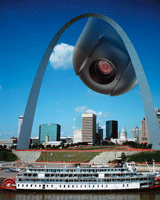
CCTV: Color or Monochrome
Monochrome, color, «day/night»?
In what ratio are these integral components of video surveillance systems currently located on the market?
Experts know that black and white cameras are extremely rarely used today.
Abroad, for example, it is generally difficult to find a video surveillance system built on monochrome cameras. But one cannot help but note this trend: classic color cameras are also used less and less. How can one not recall the words of a classic writer who was once studied and summarized by everyone: «Any extreme is bad.»
True, we will recall this phrase with some amendment: any of these extremes was quite acceptable until very good intermediate options appeared. I mean cameras that experts call «day/night».
Their development and mass production were caused by urgent market demands. Because the use of both color and black-and-white cameras has considerable and sometimes very inconvenient for users limitations.
Even non-specialists understand the limitations of monochrome cameras. They do not transmit images in color. And this is completely unacceptable in cases where it is necessary not only to observe the situation, but also to distinguish colors. There is still an opinion that observation in color does not bring practical benefits.
Meanwhile, there are a number of visual tasks that can be solved exclusively by color video surveillance.
There are many examples: parking lots, when it is necessary to know the color of the cars leaving them.
Places where people gather, shops. The same casinos, where it happens that it is very important to reliably examine not only the fact of the presence of the card itself on the gaming table, but also to examine its suit and denomination. I am not even talking about the fact that color cameras are much preferable when observing low-contrast objects.
The price of color and black-and-white cameras has not differed significantly for a long time. By the way, if we mean not just the cost of cameras, but the cost of the entire system, then there has never been such a difference.
I remember well the case when one of our customers was against installing color cameras precisely because of their high cost compared to black-and-white ones, although a color system was needed to solve the problems of protecting the facility.
Then we managed to convince the customer, and the main argument for him was the final cost of the entire video surveillance system, including installation work. It exceeded the estimate for monochrome equipment by only a little over twenty percent.
Color surveillance is much more informative than black and white, but only if the object is sufficiently illuminated.
And here monochrome cameras take over. They are practically irreplaceable, say, when equipping perimeter systems. Indeed, with current electricity prices, and it is clear to everyone that they will not decrease in the foreseeable future, it is hardly economically feasible to illuminate a section of the fence all night. It is much simpler and cheaper to install black and white cameras with IR illumination.
Day/night cameras have largely eliminated the problems of building effective video surveillance systems.
There are two types of such cameras on the market today. In one case, the night mode is achieved by digital signal processing, increasing sensitivity and automatic gain control and cleaning from additional noise, i.e. the parameters of the matrix itself are improved. But in the «night» mode, it does not completely replace the monochrome camera.
And at the same time, it cannot work with infrared illumination. Basically, the camera still remains color.
The simplest example: if you enter a semi-dark room, then after your eyes adapt a little to the semi-darkness, you still won't be able to distinguish colors. You'll see everything as gray. But this is the human eye, whose color perception is many orders of magnitude higher than that of the best camera.
When the illumination drops, the camera's color components are sharply reduced. And they are sort of filtered out so as not to interfere.
The camera seems to switch to black and white mode. In fact, this mode is more correctly defined as gray.
In all color cameras, both conventional and with the «day/night» mode described above, the separation into color components is carried out by a special filter. It divides the signal into three colors: red, green, blue.
Three pixels are involved in the matrix to obtain the corresponding color. Since the filter selects the red, green and blue region of the spectrum, the IR radiation is cut off by the filter, the camera does not see anything in this area.
These three pixels give one pixel of perception. Therefore, the sensitivity is low.
Another type of color day/night cameras involves a complete transition to black and white mode. The transition to black and white mode is carried out at a certain minimum illumination, while the color-forming filter is removed mechanically. And now each pixel becomes a black and white converter.
The camera becomes fully black and white without any limitations on characteristics. The electronics that control the signal conversion switches to another mode.
A camera without a retractable filter in black and white mode provides 0.01 lux. After that, there is solid noise. And with a retractable filter, the sensitivity and, accordingly, the resolution are an order of magnitude higher. Because each pixel creates its own visible image.

The main thing is that there are no and cannot be any contradictions between color and non-color observation.
There are various design solutions to the problem that the system faces.
I don't see any obstacles to installing classic color cameras in an office space or, say, in a store where there is constant lighting, quite sufficient to form a normal picture. At night, the facility is usually locked and set to a security alarm. And if the facility has 24-hour physical security, there must be a standby lighting mode.
In places where there is insufficient lighting at night to obtain a normal color image, which is not always required for security, day/night cameras are quite suitable, in which the same gray image is achieved using digital signal processing and AGC.
In such cases, it is not necessary to determine what color jacket the person in the frame is wearing, but it is very clear that the person appeared in a place where no one should be, and that he is wearing a jacket, not a coat or a sheepskin coat. That is, if the system gives the operator exactly the information he needs, the system has every right to exist. Moreover, under normal lighting, cameras provide a good color picture.
Day/night cameras with a retractable filter are used where full-fledged black-and-white cameras are needed at night.
It should be remembered that a monochrome camera does not work in pitch darkness either. It works at dusk.
The value of 0.01 lux corresponds to a moonlit night (preferably during the full moon) with a clear sky.
How often does this kind of weather happen?
And is it possible not to take into account its inevitable vagaries when installing a security television system?
Of course not.
But these cameras, as we remember, work with IR illumination. Its use gives a very good result: you will get a black and white picture acceptable for perception.

Добавить комментарий